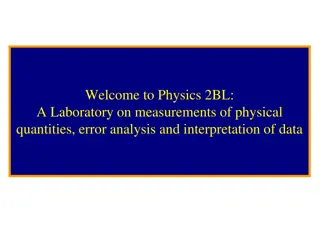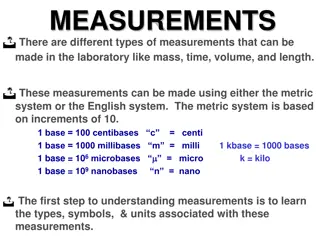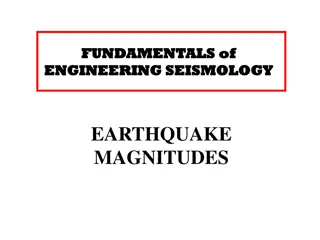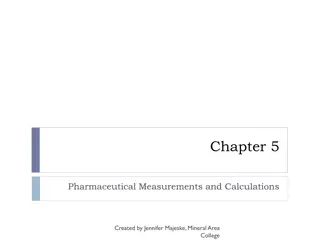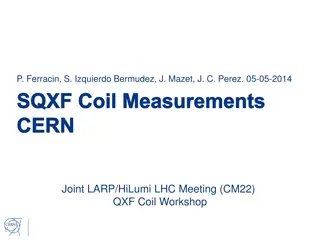Fundamentals of Physical Measurements
Science and engineering rely on measurements to understand natural phenomena. Physics aims to predict future outcomes based on observed data and fundamental laws. Base physical quantities like length, time, and mass have standard units, forming the foundation for deriving other physical quantities. Understanding atomic mass units, conversion factors, and order of magnitude enhances the precision of measurements in physics.
Download Presentation

Please find below an Image/Link to download the presentation.
The content on the website is provided AS IS for your information and personal use only. It may not be sold, licensed, or shared on other websites without obtaining consent from the author.If you encounter any issues during the download, it is possible that the publisher has removed the file from their server.
You are allowed to download the files provided on this website for personal or commercial use, subject to the condition that they are used lawfully. All files are the property of their respective owners.
The content on the website is provided AS IS for your information and personal use only. It may not be sold, licensed, or shared on other websites without obtaining consent from the author.
E N D
Presentation Transcript
Science and engineering are based on measurements, observation and comparisons. The main objective of physics is to understand things happening in nature. We, the physicist always try to predict things by formulating ,what we observed and measured, by fundamental laws that allow us to predict the result of future experiments. The outcome of what we are doing was the origin of many technologies such as electronics, optics, nuclear energy, special materials etc.
We describe natural phenomena by few base physical quantities ,that can be measured , such as length, time , mass, electric current, temperature, Luminous Intensity and the amount of substance. Each base physical quantity has a standard value and unit that a sign to it. Example: In SI unit system Length is measured in meters (m) Time is measured in seconds (s) Mass is measured in Kilograms (kg) All other physical quantities can be derived from the above base physical quantities such as force, velocity, energy etc.
https://www.technologyuk.net/physics/measurement-and-units/physical-https://www.technologyuk.net/physics/measurement-and-units/physical- quantities-and-si-units.shtml
Another mass standard is atomic mass unit (u) In this unit the mass of carbon 12 atom = 12u Where u = 1.6605402 10 23kg Its relation with Avogadro s number can be obtained as follow: Mass of 12? Mass of one mole of 12? One mole contain Avogadro s number (??)atoms. = 12u =12g 1 12? ??= 12? ? = ??g
Changing Units We needs a conversion equation that gives the relation between units in question. For example: Conversion eqn. 1 min = 60 s Conversion factor 1 =1 ??? 60 ? 60 ? 1 ??? Or Conversion factor 1 =
Order of Magnitude Order of magnitude is expressed in scientific notation as the power of ten. ? = ? 10?where 0.5<a<5 and b is the order of magnetude For example order of magnitude of the number 2.3 107is 7 and the order of magnitude of the number 8.9 104is 5 Note: the number 8.9 104should be written as 0.89 105
Significant Figures (S.F.) and Decimal Places (D.P.) The number 51.1 has three S.F. and one D.P. The number 51.10 has four S.F. and two D.P. The number 511.0 has four S.F. and one D.P. The number 0.0511 has three S.F. and four D.P.
Math With Significant Figures Significant Figures (S.F.) and Decimal Places (D.P.) In multiplication and division: the number of S.F. of the result is equal to the S.F. of the number that has the least S.F. In addition and subtraction : the number of D.P. of the result is equal to the D.P. of the number that has the least D.P.
Examples: Using the calculator 5.301 2.2 =11.6622 The correct presentation of the result 12, because the result according to rule of division and multiplication should has only two S.F. Using the calculator 5.301 + 2.2 = 7.501 The correct presentation of the result 7.5, because the result according to rule addition and subtraction should has only one D.P.
Dimensions Analysis physical quantities physical quantities dimensional analysis is the analysis of the relationships between different physical quantities by identifying their base quantities base quantities ???? ? ? ????????? ?? ???? = ? ????? ? ? ????????? ?? ????? = ? ???? ? ? ????????? ?? ???? = ?





